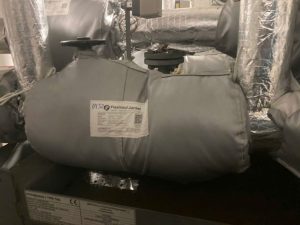Insulation jackets (also known as removable insulation blankets) are a flexible and effective insulation solution for industrial piping systems, valves, and machinery. But how can you tell if they are performing well or silently causing energy loss? Regular inspection with a thermal camera not only verifies the performance of the insulation jacket but also helps detect heat leaks early, thereby optimizing operating costs and ensuring safety.
What Are Insulation Jackets and Why Check Their Effectiveness?
Definition of Insulation Jackets (Removable Blankets)
Insulation jackets, also known as removable insulation covers, are products designed to wrap around industrial equipment such as valves, flanges, pipes, tanks, and other complex-shaped machinery parts. They are constructed from multiple layers of high-quality insulation materials that are resistant to high temperatures, water, and corrosion.
The main advantage of removable insulation jackets over permanent insulation is their flexibility: they can be easily removed and reinstalled for equipment maintenance and repair without damaging the insulation structure.
Benefits of Inspecting Insulation Jacket Effectiveness
Regularly inspecting the performance of insulation jackets offers many practical benefits:
- Reduce energy costs: Detect and promptly fix areas of heat loss, minimizing energy waste and significantly saving on operational expenses.
- Ensure workplace safety: Keep the surface temperature of equipment and pipes at a safe level, preventing the risk of burns for operators.
- Protect and extend equipment lifespan: Maintain stable operating temperatures for machinery, helping equipment run more reliably and reducing maintenance and repair costs.
- Provide data for optimization: Measurement data offers precise information to assess the quality of insulation products and to plan maintenance proactively and effectively.
How to Measure Insulation Jacket Effectiveness with a Thermal Camera (4 Steps)
Using a thermal camera (infrared thermal imager) is the most modern, quick, and visual method to assess the performance of insulation jackets. This technology allows you to “see” temperature and displays thermal differences as a color spectrum image.
Step 1: Prepare Equipment and Safety Gear
- Equipment: Use a thermal camera with a resolution and temperature range suitable for the plant’s actual application. Ensure the device is calibrated and fully charged.
- Safety: The operator should have basic knowledge of infrared thermography principles and adhere to all workplace safety regulations in the area.
Step 2: Conduct a General Surface Scan
Scan the entire surface of the areas where insulation jackets are installed. Move the camera slowly and steadily to capture a complete thermal image. Visually compare the surface temperature of the insulated areas with uninsulated areas or suspected faulty spots.
Step 3: Analyze the Image and Identify “Hot Spots”
- Find “Hot Spots”: Pay attention to areas with bright colors (usually yellow, orange, red) in the thermal image. These are locations with abnormally high surface temperatures, indicating heat is being lost. The cause could be a poorly fitted insulation jacket, deformed material, or degraded quality.
- Measure specific temperatures: Use the spot meter tool on the camera to record the exact temperature at key locations: the center of the insulation jacket surface, the newly identified hot spots, and a nearby uninsulated pipe/equipment area for comparison.
Step 4: Create a Report and Propose Solutions
- Save both the thermal and standard digital images of the problematic areas for easy comparison.
- Prepare a detailed report describing the location, the degree of temperature difference, and a preliminary estimate of energy loss.
- Recommend corrective actions such as re-tightening straps, repairing, or replacing insulation jackets that are no longer effective.
How to Read and Interpret Thermal Imaging Results
Analyzing the results is highly intuitive:
What Indicates Good Performance?
The thermal image shows a uniform, cool color (usually blue, purple) across the entire surface of the insulation jacket. The jacket’s surface temperature is only slightly higher than the ambient temperature.
What Are the Signs of Poor Performance?
The thermal image displays streaks, spots, or areas of bright colors (yellow, orange, red). This indicates significant heat leakage. A large temperature difference between the insulation jacket’s surface and the environment proves the jacket is not performing its insulation function correctly.
By applying infrared thermography, businesses can proactively manage their insulation systems, ensuring energy efficiency and operational safety.
Request consultation and quotation now!Frequently Asked Questions
What is the main purpose of an insulation jacket?
Insulation jackets are used to insulate valves, pipes, and machinery, helping to reduce energy loss, ensure operator safety, and protect equipment from thermal fluctuations.
Why is it necessary to insulate valves and pipes?
Valves and pipes are the most common points of heat loss in a system. Insulation helps maintain stable temperatures, save energy, and reduce the risk of burns.
How does a thermal camera detect heat loss?
A thermal camera captures infrared radiation (heat) invisible to the naked eye and converts it into a color spectrum image. Areas with higher temperatures (heat loss points) will appear in brighter colors (yellow, red) compared to their surroundings.
When should insulation jackets be inspected or replaced?
Periodic inspections are recommended, for example, every 6 to 12 months. Replacement is needed if the jacket is torn, deformed, the internal insulation material is wet, or when thermal imaging results show a significant decline in insulation performance.










